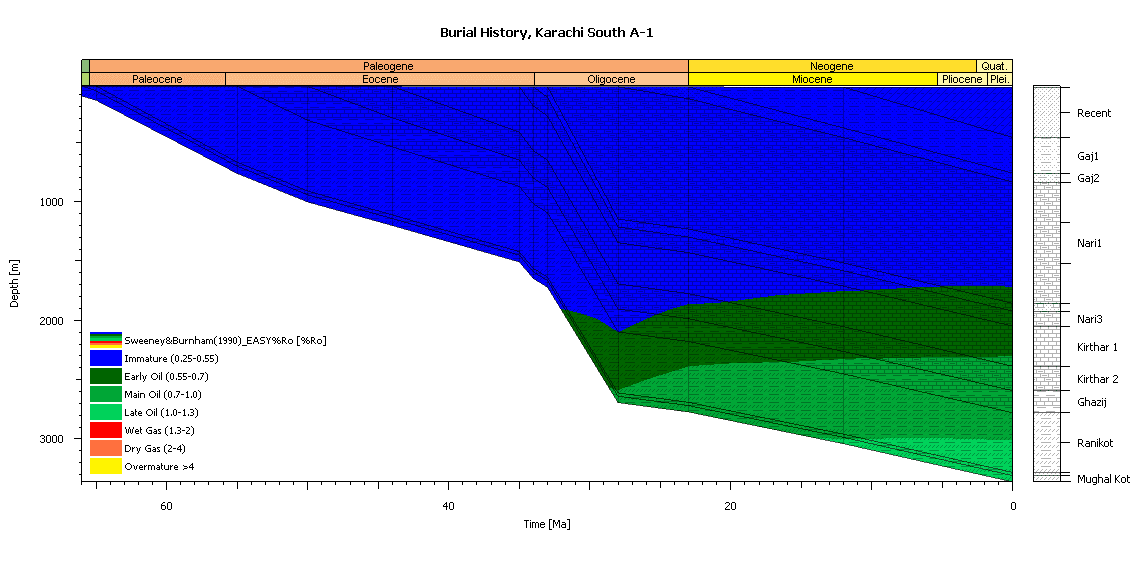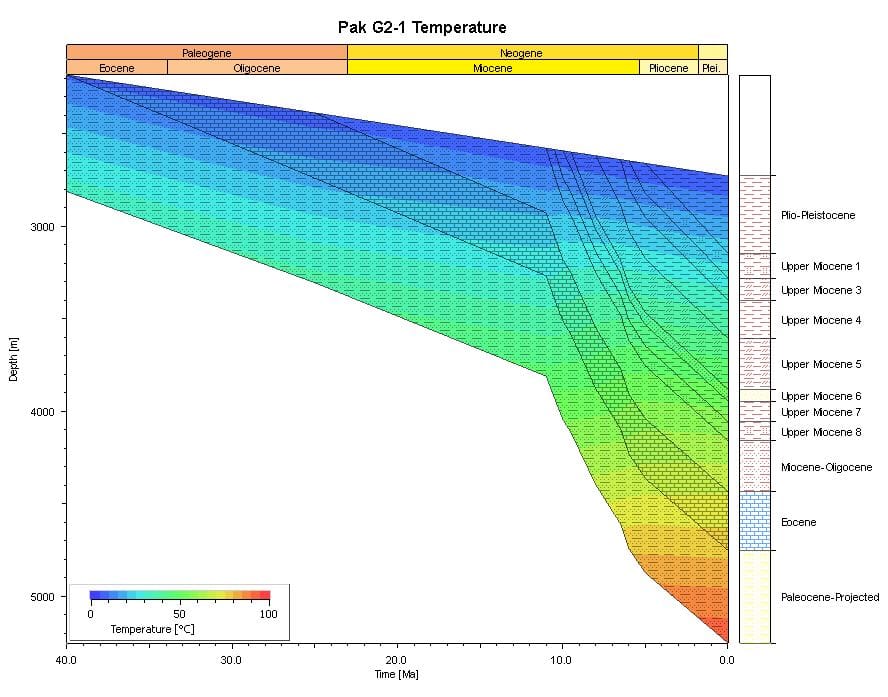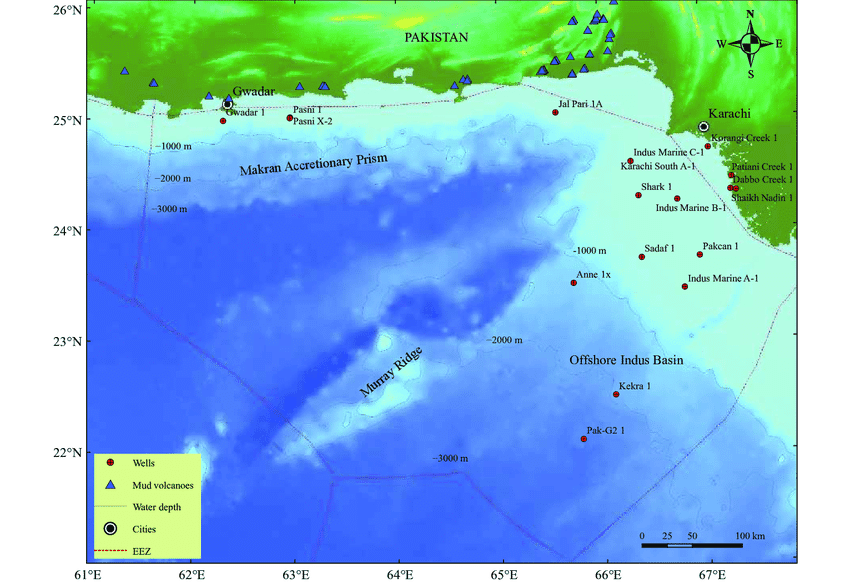Offshore exploration in Pakistan began in 1963, with Sun drilling three wells in the Indus Delta’s shallow waters: Dhabo Creek-01, Patiani Creek-01, and Korangi Creek-01. Subsequent attempts included Wintershall’s Indus Marine A-1 and B-1 wells in 1972, and Indus Marine C-1 in 1975. In 1976, Marathon drilled the Jal Pari 1A well, which encountered high pressure and forced a halt in drilling. Later, Husky Energy’s 1978 Karachi South-1 well revealed shaly source rocks in the Mughalkot Formation beneath the Deccan volcanic series, though the reservoir quality was poor. In 1985, OGDCL’s Pakcan-1 discovered gas in the Miocene; however, further efforts, such as Oxy’s 1989 Sadaf-1, yielded no significant results. The 1990s and 2000s saw additional wells by Canterbury, OPC, PPL, and Total Energies, including Pasni-1 and Gwadar-1, yet these too were largely unproductive. The most recent exploration, Kekra-1 by ENI in 2019, also yielded no viable resources. This outcome is likely due to a lack of hydrocarbon charge, attributed to the absence of Early Cretaceous source rocks in the area. No shallow source rocks could be established, despite some occurrences of thermogenic gas.

Geological Influence of Plate Collision
The collision between the Indian Plate and Eurasian Plate created the Himalayas and initiated significant erosion, transporting sediments southward to form the Indus Fan in the Arabian Sea, one of the world’s largest sedimentary fans. The uplift accelerated erosion, feeding massive sediment into the Arabian Sea and building the Indus Fan. Following the continental collision between the Indian and Eurasian plates in the Oligocene, the influx of clastic sediments buried Paleogene carbonates in the offshore Indus Basin. This process intensified from the mid-Miocene onward, with uplifting and tilting of turbidites east of Murray Ridge. The Upper Oligocene to Recent Indus Fan clastics now form a thick succession of channel-levee systems.
Hydrocarbon Potential and Challenges
Data from offshore wells has yet to show evidence of significant Tertiary-age source rocks, and deeper sections remain largely unassessed. The thick Eocene to Pliocene deposits in the Indus Fan have shifted initial oil-rich zones into the gas window, creating migration barriers due to impermeable basal shale layers. Future drilling could reveal if hydrocarbons bypass these barriers through fault systems intersecting source rock. Findings from deepwater wells, such as Pak G2-1, indicate immature rocks for hydrocarbon generation. If the drilled sections are extrapolated to Paleocene Ranikot Formation, Ro levels around 0.4-0.5% suggesting early maturation for oil generation but lack of data and unconformity between Upper Miocene and Upper Eocene make the accurate predictions of thermal maturity very hard as all readings of present maturity are above unconformity. That’s why the Paleocene hydrocarbon potential might be overstated given limited data, as regional modeling suggests Paleocene source rocks may have become post-mature by the Oligocene, potentially charging Miocene and younger reservoirs via shallower source rocks would have occurred.
In contrast, wells like Karachi South A-1 and Pakcan-1 (Paleocene-Eocene to Mid-Miocene intervals) remain within the hydrocarbon window. Although Pakcan-1 confirms thermogenic gas, data limitations impede a complete source rock assessment across the basin. Ghazij Formation modeling based on Karachi South A-1 suggests it reaches the peak oil window (Figure-01) and about to approach the gas window.
Exploration Outlook and Economic Incentives
In the Lower Indus Basin, the Lower Cretaceous Sembar and Goru formations serve as primary source intervals; however, their offshore extension places them beneath Deccan volcanic rocks, rendering them less viable for the Indus Fan play. Offshore, rapid sedimentation has lowered geothermal gradients, reducing the likelihood of source rock maturation to depths comparable to onshore zones.
Seismic interpretation reveals laminated Deccan basalts within Upper Cretaceous–Paleocene marine-facies strata in the southeastern basin, adjacent to the Somanath Ridge and Saurashtra High (Khurram et al., 2019). Conversely, the northwestern basin, with minimal basalt influence and proximity to the Murray Ridge strike-slip fault zone, may offer potential for oil and gas exploration. With developed fault structures near Murray Ridge, the northwestern region is promising, presenting opportunities to uncover established Cretaceous plays.
To reduce import dependency, the government has introduced favorable terms, including a gas price of US$7-9/MMBtu and contractor profit shares up to 95%, aiming to attract foreign investment. While exploration results have been limited, recent multi-year surveys suggest offshore Pakistan still holds potential.

Reference
Calves G, Schwab AM, Huuse M, Peter DC, Asif I. 2010. Thermal regime of the northwest Indian rifted margin Comparison with Predictions. Marine and Petroleum Geology, 27, 1133–1147. doi: 10.1016/j.marpetgeo.2010.02.010.
Chatterjee S, Goswami A, Scotese. 2013. The longest voyage: Tectonic, magmatic, and paleoclimatic evolution of the Indian plate during its northward flight from Gondwana to Asia. Gondwana Research, 23, 238–267. doi: 10.1016/j.gr.2012.07.001.
Jian-ming Gonga, b, c, Jing Liaoa, b, *, Jie Lianga, b, Bao-hua Leia, b, Jian-wen Chena, b, Muhammad Khalid, Syed Waseem Haidere, Ming Meng. Exploration prospects of oil and gas in the Northwestern part of the Offshore Indus Basin, Pakistan
Shahzad K, Betzler C, Ahmed N, Qayyum F, Spezzaferri S, Qadir A. 2018. Growth and demise of a Paleogene isolated carbonate platform of the Offshore Indus Basin, Pakistan: Effects of regional and local controlling factors. International Journal of Earth Sciences, 107, 481–504. doi: 10.1007/s00531-017-1504-7.

